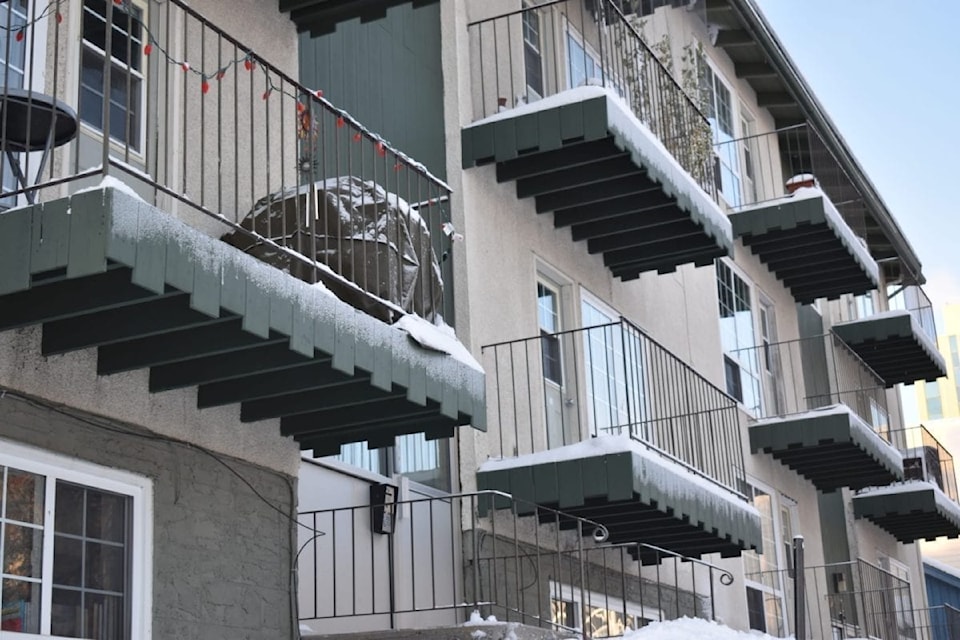Eviction orders have climbed steadily over the last decade according to the Rental Officer’s annual report tabled in the Legislative Assembly Dec. 10.
There were 217 eviction orders in the report’s time frame of April 2018 to March 2019. That’s up from 150 and 153, respectively from 2016-17 and 2017-18. Before that, the last three reports found 86, 114, and 127 evictions, respectively.
Tenancy termination and eviction orders accounted for roughly 50 per cent and 49 per cent, respectively, of all applications heard last year, rental officer Adelle Guigon stated in the report.
These orders are more common for subsidized public housing tenancies, rather than private properties.

Photo Courtesy of NWT Rental Office
“That’s not something to take lightly … people’s stories don’t stop there,” said Memorial University professor Julia Christensen, who studies Northern housing and wrote a book on homelessness in Yellowknife and Inuvik.
Christensen’s research found there can be few options available to evicted tenants, especially if they are leaving one of the main landlords in Yellowknife.
“Evictions in (the city), or really anywhere else in the Northwest Territories, often leads to homelessness, whether it’s short term or long term,” she said.
The increase is an interesting finding, noted Christensen, considering the vacancy rate has also slightly increased in recent years. Intuitively this would mean less competition for rental units, leading the report to come as something of a surprise.
She said her main concern was the impact on individuals after being evicted.
“What this is kind of showing is perhaps landlords aren’t feeling too pressed and in too much of a place where they have to keep a tenant if they’re not satisfied with the tenant,” she said.
“They’re obviously feeling there’s enough of a tenant market out there that they can afford to be increasing the number of evictions.”
There are also costs to consider. Those paying rent higher than an affordable 30 per cent of income roughly doubled from 1,059 in 2016 to 2,090 in 2019, according to a November GNWT report.
Yellowknife’s average rent is $1,613, according to the Canadian Rental Housing Index.
In 2018, the Canadian Mortgage and Housing Corporation reported 2,500 Yellowknifers cannot affordably secure market rental housing.
Christensen said evictions and rental arrears are significant contributors to homelessness.
Due to a shortage in public housing stock, single low-income adults also tend to seek housing in the private rental market covered by the rental officer, as indicated in a 2011 Homeless Hub report.
While the rental officer report only covers the total number of evictions, Christensen said it was important to consider who specifically was impacted.
“Who are the people being evicted and how is the particularly vulnerable group being impacted?” she said, noting behaviours leading to eviction may require additional social and health supports.

Nick Pearce/NNSL photo
The report also expressed concern over 31‐day‐or‐less fixed‐term tenancy agreements, saying their use appears to have a “punitive purpose involving multiple back‐to‐back (agreements).”
Consecutive terminations can be held over a “tenant’s head in an attempt to control their behaviour,” she added.
The Residential Tenancies Act doesn’t require cause, meaning the tenant can’t dispute termination, the report stated.
Later in the report, the officer called it “unnecessary, redundant, and excessive, providing an unreasonable amount of power to subsidized public housing landlords.”
Professor Christensen said these circumstances are a sign that landlords need assistance understanding the needs of their tenants, who may be experiencing crises. Similarly, she added, tenants need support to deal with the issues before they lead to eviction.
“Everyone in this situation is in a difficult spot,” she said.
The report also noted instances of landlords withholding security deposits. In these cases, it suggested several landlords were unaware that lost future rent doesn’t count as rental arrears.
However, some landlords intentionally retain the security deposit, aware they are in contravention of the act.
“Usually they are counting on the tenant either not knowing that the security deposit cannot be retained against lost future rent, not knowing that they have the option to file an application for the return of the security deposit, or not being willing to pursue making the application,” stated the report.
Cases of unlawful seizure, meanwhile, are relatively rare, according to the report.
There was, however, one case in 2018 where a landlord held a tenant’s vehicle pending “payment of the security deposit in full, payment of the first month’s rent, provision of post‐dated rent cheques for the remainder of the fixed‐term tenancy, proof of tenant insurance, and proof of transfer of the electricity account to the tenant’s name.”
While the officer found the landlord to be breaching the act, there were no means to grant the tenant compensation. In the report, the rental officer requested that the act be changed to grant tenants compensation.
Holding onto property either through a security deposit or a tenant’s vehicle have a significant impact when a tenant has limited resources.
Individuals in these situations rarely understand their rights or the resources available to them, Christensen added, which can lead to “being taken advantage of, or (having) their rights abused in these kinds of situations.”
